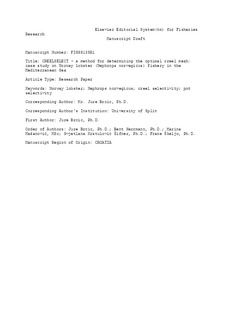| dc.contributor.author | Brčić, Jure | |
| dc.contributor.author | Herrmann, Bent | |
| dc.contributor.author | Mašanović, Marina | |
| dc.contributor.author | Šifner, Svjetlana Krstulović | |
| dc.contributor.author | Škeljo, Frane | |
| dc.date.accessioned | 2019-03-31T18:39:13Z | |
| dc.date.available | 2019-03-31T18:39:13Z | |
| dc.date.created | 2018-06-18T15:33:35Z | |
| dc.date.issued | 2018-08 | |
| dc.identifier.citation | Fisheries Research. 2018, 204 433-440. | nb_NO |
| dc.identifier.issn | 0165-7836 | |
| dc.identifier.uri | http://hdl.handle.net/11250/2592571 | |
| dc.description.abstract | In the laboratory, we investigated which sizes of Nephrops (Nephrops norvegicus) could pass through the meshes of different size and shape to establish a predictive model for the creels size selectivity. Predictions agreed well with the results from experimental fishing, demonstrating the reliability of this simple method. Nephrops minimum target size is 20 mm carapace length in the Mediterranean creel fishery, with some areas having restrictions on the mesh size, minimum being 36 or 40 mm. The model predicts that Nephrops below 28 and 32 mm carapace length would escape from creels with respectively 36 and 40 mm mesh size, implying a suboptimal exploitation pattern. Our method provides easy and quick identification of optimal mesh size and shape without the exhaustive sea trials with various creel designs. It was predicted that a square mesh of 30 mm would better match the desired exploitation pattern. The method could easily be adopted to other species and different creel fisheries, helping to determine optimal mesh matching a prescribed exploitation pattern. | nb_NO |
| dc.language.iso | eng | nb_NO |
| dc.rights | Attribution-NonCommercial-NoDerivatives 4.0 Internasjonal | * |
| dc.rights.uri | http://creativecommons.org/licenses/by-nc-nd/4.0/deed.no | * |
| dc.subject | Norway lobster | nb_NO |
| dc.subject | Nephrops norvegicus | nb_NO |
| dc.subject | Creel selectivity | nb_NO |
| dc.subject | Pot selectivity | nb_NO |
| dc.title | CREELSELECT—A method for determining the optimal creel mesh: Case study on Norway lobster (Nephrops norvegicus) fishery in the Mediterranean Sea | nb_NO |
| dc.type | Journal article | nb_NO |
| dc.type | Peer reviewed | nb_NO |
| dc.description.version | acceptedVersion | nb_NO |
| dc.source.pagenumber | 433-440 | nb_NO |
| dc.source.volume | 204 | nb_NO |
| dc.source.journal | Fisheries Research | nb_NO |
| dc.identifier.doi | 10.1016/j.fishres.2018.03.020 | |
| dc.identifier.cristin | 1592008 | |
| cristin.unitcode | 7566,2,0,0 | |
| cristin.unitname | Sjømatteknologi | |
| cristin.ispublished | true | |
| cristin.fulltext | postprint | |
| cristin.qualitycode | 1 | |

